 |
surfresearch.com.au
tom morey
: noseriding contest, 1965
|
Tom Morey's Noserider Contest
Ventura, California.
3 - 4th July 1965
Selections from Surfer
January 1965 -January 1966.
| home | catalogue | history | references | appendix |
 |
surfresearch.com.au
tom morey
: noseriding contest, 1965
|
| Tom
Morey's Nose
Riding Contest at Ventura in mid-1965 had a
significant impact on
Californian surfing technique and surfboard design until
1968, when the
American market was substantially challenged by the
influence of "short-board
revolution", commonly thought to have originated in
Australia in mid-1967.
Morey
designed the
contest to apply objective judging criteria to
performance and encourage
board designers to concentrate on one specific design
feature.
Existing
film confirms
much of the subsequent written accounts of the contest
and also indicates
that the collation of the scores was, at best,
rudimentary.
|
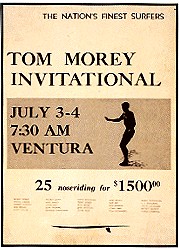
(1997), page 103. |
On the day,
the Hobie
Surfboards team, riding a number of boards specifically
designed by Phil
Edwards, won both natural and goofy first places.
However, "by
a
judging error ; Mike Hynson of San Deigo actually won."
- Kampion: Stoked
(1997) page 103.
Surfer
Magazine
first reported on the Morey Noseriding Contest in September
1965 in an
article by Patrick McNulty: "Their surfing for big
contest $$$"
Surfer
Magazine
September 1965, Volume 6 Number 4, pages 64 to 69
Page 69
...
Surfing's
trend
to professionalism was underscored over the Fourth of July
weekend when
the Tom Morey Invitational scattered hard cash for some of
best surfers
in the sport.
Thee
contest was
really unique- not only for offering cash prizes.
The 24
specially
invited surfers who put up a $50 entry fee to back up their
reputations
were judged solely on nose riding.
They were
graded
on exactly how long- by a stop watch- they could ride the
nose across Ventura
Point waves.
The contest
brought
out some weird, specially-built boards as well as such
surfers as Corky
CarroII, Donald Takayama, Robert August, Dewey Weber and
Mickey Munoz.
Nose-riding
off
with the top prizes were Munoz and goofy-footer Corky
Carroll.
There were
two
divisions -Regular and Goofy-Foot.
After the
Morey
contest the stoked "professional" surfers raised the battle
"On to Lahaina."
Another
nose-riding
contest is planned for this famous whaling port on the
Hawaii island of
Maui in the fall.
The contest
is
planned along the lines of the Ventura contest with entry
fees and a pot
of gold worth $7000.
It looks as
if
the old days when surfing contests were held just for fun
and not for profit
are long gone.
Evidence that
the
projected contest on Maui ever eventuated is, currently,
unclear, however
there is a report of a second noseriding contest held at
Ventura in
November, 1966 (see below).
It was about
another
ten years before McNulty's prophesy, that surfing was about to
enter a
professional competitive era, was fully realised.
In the same
edition
of Surfer, Hobie Surfboards offered a teaser to the up
coming release
of their noseriding model on the prestigious page two, inside
the front
cover.
Hobie
Surfboards:
What
are they talking about? (Advertisement)
Surfer
Magazine
September 1965, Volume 6 Number 4, page 2.
Under a
photograph
of the team members sitting around several boards on the
beach, the text
read:
What do you
think
they are saying? -They are saying, be serious, our picture
is being taken.
But what
they
really have been talking about lately is the new model HOBIE
SURFBOARD
that will be out soon.
We wish that
we could tell you more about it, but we still have some more
experimenting
to do.
We do feel
that
we have discovered something big in surfboard design using a
new principle
in bottom shape.
In the past
we
have the mistake of bringing out some things too quickly,
but other innovations
we have taken too long to introduce and have been copied so
fast that no
one knew who originated the idea.
We feel that
our new board is worth protecting as it well could be the
basic design
for all future surfboards.
By the next
issue
of SURFER we should have it perfected and available.
The HOBIE
SURFBOARD
SHOP was the originator of the modern surfboard and first
with a signature
model (Phil Edwards).
We are first
in competition, too.
So far this
year
we have compiled 58 points in overall USSA competition to
our next competitor's
34 points.
Now with a
new
shape of surfboard, designed by Phil Edwards, we may be
first in revolutionizing
surfboard design.
The next
edition
of Surfer was designated as an "Special Nose
Riding Issue",
featuring several pertinent articles and advertisements by
surfboard manufacturers.
Bill Cleary
looked
back at the Morey Contest in "Nose Riding - A sport
within a sport."
Surfer
Magazine,
November 1965, Volume 6 Number 5, pages 24 to 35.
Page 29
...
The Tom
Morey
Invitational (held in July at Ventura, California) provides
us a good example,
for here was a contest devoted exclusively to noseriding.
Twenty-two
of
California's best surfers were invited to participate for
$750 in cash
prizes.
Twenty-five
percent
of the board's length was defined as the nose.
Those
surfers
who spent the most time on the nose, as measured by judges
with stopwatches,
were the winners.
This was the
first surfing contest ever held in which a winner was
determined by objective
criteria.
But the real
importance for development of the sport was that there were
"no equipment
restrictions."
Manufacturers
were
stimulated to create a specialized surfboard -one designed
to be ridden
most efficiently on the nose under the surf conditions at a
specific surfing
spot.
There were
categories
for stock boards and special boards, left-foot leads and
right-foot leads.
The special
boards
ran away with it: Munoz (Hobie Surfboards), Hynson (Gordon
and
Smith Surfboards)
and Carroll (Hobie) clocked noserides of 9.9,
9.8 and 9.6 seconds, respectively, while in the stock board
class Nuuhiwa
(Bing Surfboards)
and Leonardo
(unknown)
tied for the longest
nose rides at 5.8 seconds.
The vast
difference
in performance between the two classes cannot be explained
by a greater
or lesser ability on the nose.
The answer
is
- Equipment: and all ...
Page 32
... the
prototype
boards designed by the various manufacturers functioned
beautifully.
Page 35
...
So watch the
new boards.
Watch the
new
surfers.
A new era of
nose-riding may be at hand.
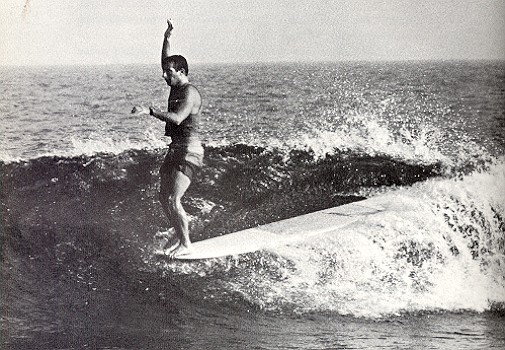 |
Tom Morey's Nose Riding Contest, Ventura, July 1965. Photograph by Bruce Brown. Edwards (1967) page 122. |
| Corky
Carroll and Hobie Nose-Rider, Poche, July 1965.
Photograph by Ron Stoner Kampion (1997) page 105. For
Corky Carroll's
comments on the Morey Noseriding Contest, see:
The
fleet of boards
prepared for Hobie Team members by Phil Edwards and
Hobie Alter featured
a deeply concaved nose design and its competive
success and advantages
were heavily promoted in advertisements and articles.
Phil
Edwards gave
a brief, but erudite, technical analysis of the
design's development to
Bill Cleary for |
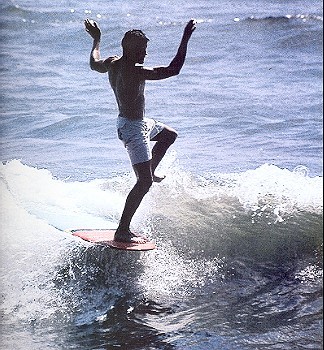 |
Designer
Phil
Edwards explained that it was not the ideas behind the board
that were
unique, but collective application of them.
He credited
the
board's basic ideas to an earlier inventor: "Simmons was the
only one who
ever took a real academic approach to the thing (design).
What he did
with
surfboards is still pretty much what we're riding today.
In fact, the
best way I can describe our noseriding board is a Simmons
board with the
nose cut off - a speedboat turned backwards with planing
lines in the front.
It had all
been
done before ... but never quite like this.
We put it
all
together deliberately: the big, wide nose, the concave area,
the flat bottom
up there - all to make the surfboard trim on the nose.
In
preparation
for the contest we built three other models that had more or
less emphasis
on one of the three elements.
And they
worked.
But the
really
dramatic results came from putting all three elements
together at one time
with a single purpose in mind.
I was really
proud of it."
| Whereas
seminal
Californian board builder, Bob Simmons, had used
significant concave in
the tails of his renowned wide-tailed Spoons of the late
1940s- early 1950s,
Edwards relocated the feature to the nose.
Simmons
had based
his designs on his treasured copy of Lindsay
Lord's Naval
Architecture of Planing Hulls (1946).
Right:
Figure
29: M2
|
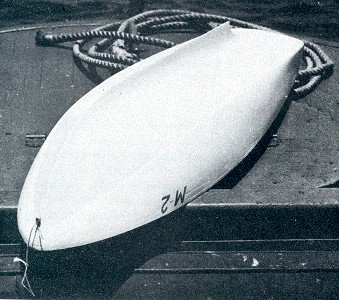 |
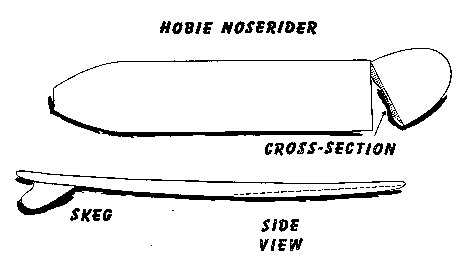 |
1965. Edwards
|
In Surfer's
Special Nose Riding Issue, Hobie Surfboards promoted
the noserider
design (hinted in the previous issue), as usual, on page two
inside the
front cover.
Some of the
accompanying
images are reproduced below (cropped):
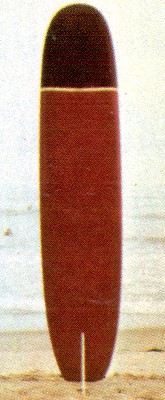 |
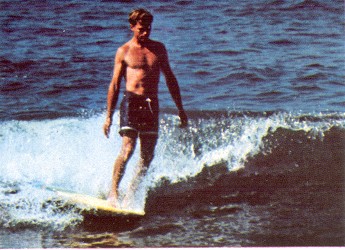
Hobie Noserider designer, Phil Edwards. Surfer November 1965, Volume 6 Number 5, page2. |
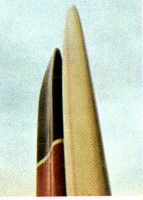 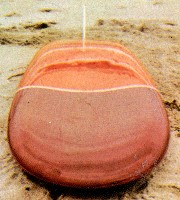 |
The
difference
in design between the Hobie Noserider and other boards
entered in the contest
was that all other makes of boards were variations of the
standard principal
of nose riding surfboards.
They had
wide
noses with good scoop and a fair amount of belly.
The Hobie
Noserider
was based around a completely opposite theory -no scoop,
with a flat planing
surface on the front third of the board and a concave bottom
in that area.
The reason
for
the board's superior performance is that by having a flat
planing section,
it doesn't push water and lose speed.
By
maintaining
its speed, it maintains its lift.
The board
also
gains additional lift by the concave bottom section.
The board
shown
above is one of the radical versions with a wider nose and
is wider over-all.
This board
has
proven to be an exceptionally fun board, especially in fast
shore breaks.
The more
practical
model is our conventional noserider has the same shape as
our standard
boards, with the concave, flat bottom section added to the
nose area.
This makes
for
an all-around performance board with superior noseriding
qualities.
This board
is
not shown because we were working on variations of it at the
time the pictures
were taken.
For further
information
on the Hobie's Noserider, contact your local Hobie dealer.
| 2.
SLIPCHECK.
A fine textured coating for the nose or tail of your board which is so firm when wet it completely eliminates slipping. Apply SLIPCHECK once, touch up occasionally. For sale in white only. One can, $3.50, is more than enough for initial coat plus touch ups.  Slipcheck aerosol can, circa 1968. |
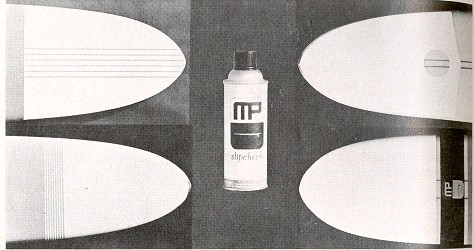
Morey-Pope Inventions: 3. Slipcheck Surfer January 1966, Volume 6 Number 6, page 66. i
|
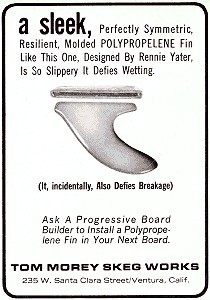 |
RennieYater
Fin by Tom Morey's Skeg Works
Polypropelene 8 x 9 1/2 b @ n/a inches (Approximation) Advertisement
for
Tom Morey Skeg Works
|
Unaccredited, and unexplained, fin designs at Morey's contest included the use of "additional contol skegs" and the "fin stabilizer":
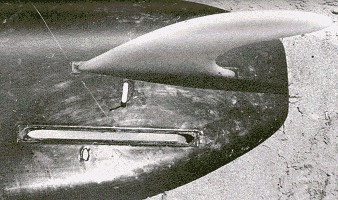 |
"additional
control skegs"
Offset Fin Boxes ? Polypropelene 8 x 9 1/2 b @ n/a inches (Approximation) Unaccredited.
|
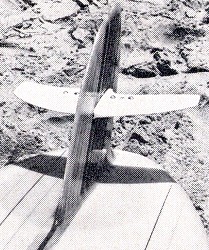 |
Fin
Stabilizer (on D fin)
??? 8 x 9 1/2 b @ n/a inches (Approximation) Unaccredited.
|
A nose
patch,
a marked section of the front 25% of the board, became a
common decor feature.
Manufacturers
often
added these, usually with coloured resin and some times a
fabric inlay,
but many riders added the decor to their boards
post-production.
This was
a
excellent marketing tool for Morey-Pope's coloured aerosol wax
alternative
-Slipcheck
and its
competitor,
Grip-Feet.
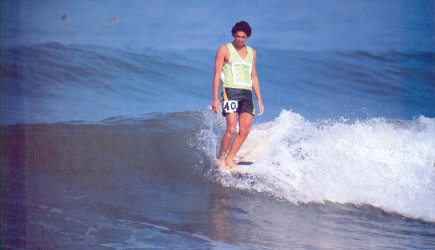 |
Photograph : Leroy Grannis Surfing Magazine March 1984 Volume 20 Number 3 page 82 |

Morey's
Second
Noseriding Contest, November 12th, 1966.
The following
account
may contain some inaccuracies.
Note that
variations
of the "10 pound bar-bell taped to a tail, and a 'Wing'
attached to
a fin" had already appeared at the first contest, the
former (a house
brick) a noted failure.
From:
http://www.theuglyclothingcompany.com/theuglylegend1.htm
It's the
crack
of dawn on Saturday, the 12th of November, 1966.
Most of the
audience,
about two thousand people, gladly pays an entrance fee of $1
to see the
performances of fifty top professional surfers from around
the world, who
gather for the Morey-Pope 2nd United States Professional
Invitational Surfing
Championships at the Ventura Fairgrounds surf spot, locally
known as "Stables."
Each of the
fifty
competitors and their surfboard manufacturer/sponsor(s) have
the intent
to push nose-riding-for-time to the extreme.
Every
surfboard
manufacturer has dug deep to come up with the ultimate
nose-riding design.
The rules
are
simple but madness abounds.
Some strange
designs appear; beside a 10 pound bar-bell taped to a tail,
and a "Wing"
attached to a fin, there are other oddities.
The
objective
timing system provides fair judging, which satisfies the
contestants and
gives the captured crowd a simple to understand test of
skill.
The winner
is
anticipated to generate more publicity than they have ever
known, great
money and prizes.
Perched like casual Gods on the nose, striking ethereal poses in effortless motion, the competitors clock incredible distances, drawing an ever building thunderous cheer.
Con
Colburn, of
Con Surf House, is the manufacturer of a top-secret design.
With Bob
Purvey,
a top competitor, at the helm, they have collaborated to
devise what seems
to them the logical curves necessary to accomplish their
goal: TO WIN!
On the last
ride
of the day Purvey catches a five foot wave "..turned high
and went to the
nose, the section came up, he backed off, dropped,
repositioned himself
with two steps and came out on the nose.
Then the
wave
broke ahead and he straightened off then turned into the
wave and clocked
two more seconds while in the soup.
He made no
mistakes
whatsoever." (from Competition Surf Magazine, Spring 1967).
Crowds ring
Purvey,
not to shake his hand but to check out his stick.


| home | catalogue | history | references | appendix |